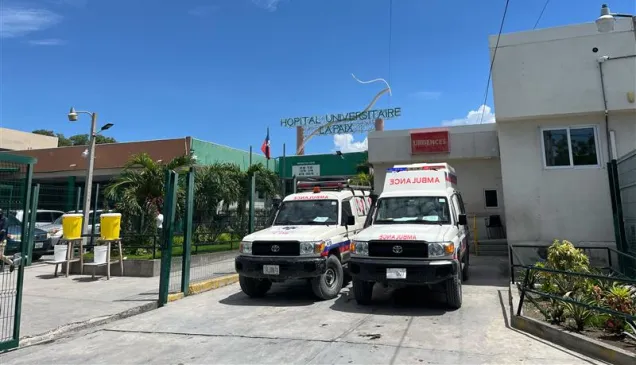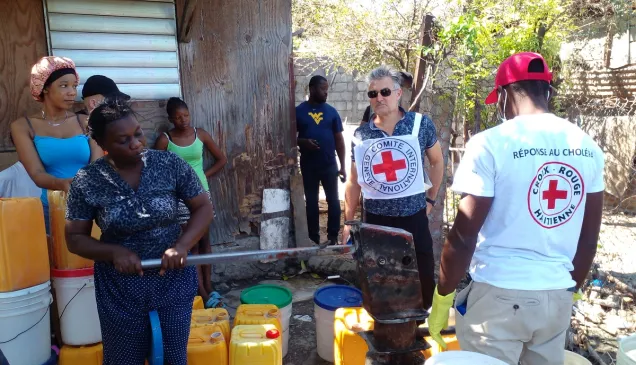Haiti: Displaced people face violence, hardship and uncertainty

Since 2021, Haiti has been mired in a spiral of armed violence, forcing thousands of people – including many women and children – to flee their homes and communities every day. Often with no possessions to their name, the lucky ones make it out of the capital, Port-au-Prince, while thousands of others remained trapped in recurring clashes between government forces and armed groups. Left to fend for themselves, often in inhumane conditions, these people must contend with other forms of violence.
Armed groups now control over 85 per cent of Port-au-Prince, and armed violence has also spread to the Centre and Artibonite departments, forcing thousands of people to flee, often without resources. One tragedy follows another, as houses are burned down or looted, and loved ones are lost. Seeking safety, these families take refuge in public or private buildings, schools, churches or anywhere else they can find shelter.

The École Nationale Argentine Bellegarde in Lalue (Port-au-Prince), once a place of learning for hundreds of children, now houses nearly 695 displaced families who have fled armed violence.
Whole families forced to flee
In the heart of the capital, the courtyard of the Argentina Bellegarde school has been transformed into a makeshift shelter, housing at least 695 displaced families. Once a place of learning, it has become a refuge for many people from areas now affected by armed violence.
"Life has been an utter misery ever since I arrived here," says Rose-Marie, a woman in her fifties who has moved countless times from one refuge to another, fleeing the chaos of violence.
"Look at the state of the wall. We spend our nights killing bugs. These are miserable living conditions for a woman of my age." Rose-Marie has been living at the school with her five children for three months now.
The constant moving, long walks and nights spent on the ground have taken their toll on her legs. And with no access to health care, her situation has deteriorated to the point where she can no longer walk or provide for her children. Recounting her circumstances brings her to tears:
"I'm sick. I've become paralysed. I used to be able to walk the streets, beg at doors and find food for my children. But now there's nothing I can do. If the violence gets any closer, I won't even be able to flee again. Perhaps my children and I will die here."
According to the United Nations, there are at least 246 sites housing internally displaced people (IDP) in Port-au-Prince. The majority are now overwhelmed by the incessant influx of new arrivals, with each accommodating an average of 2,000 people living in extreme hardship, with little or no access to water, food and health care. Hygiene and privacy are virtually non-existent.
"Living and hygiene conditions at the sites housing internally displaced people we visit are increasingly difficult," says Mamoudou Diallo, head of the International Committee of the Red Cross's Water and Habitat programme in Haiti. "Whole families are crammed into small rooms or living in sheds. Women with young children sleep on the ground, sometimes at the mercy of the elements and exposed to violence of all kinds. If nothing is done, the situation could get worse."
At the vast majority of sites housing internally displaced people, every aspect of life is an emergency. Yet families try to survive as best they can.
"The fact that we don't have any toilets makes matters worse," says Mrs Rodriguez, another displaced mother." All the toilets are blocked. Our calls for help go unanswered. We have to use bags to relieve ourselves. Others use small buckets. We are suffering enormously."

Rose-Marie, a mother of five, has fled armed violence several times. She now lives in a windowless classroom at the Argentine Bellegarde National School, which has been converted into a makeshift shelter for internally displaced persons. Living conditions are harsh in this displacement center: nights spent on a thin mat on the floor, infested with bedbugs, in the bitter cold.
Supporting displaced people living in hardship and without access to drinking water
According to the United Nations, 11 per cent of the population of Haiti is currently internally displaced. As the crisis deepens and ever more people need help, the ICRC is providing a multidimensional response, focusing on access to essential services, institutional support and protection for people affected by armed violence.
Through its Water and Habitat programme, the ICRC is supporting the distribution of hygiene kits, tarpaulins, blankets and family solar lamps to improve housing conditions for displaced people. Solar-powered street lamps have also been installed to make the sites safer at night.
On the sanitation front, the ICRC is working with the Haitian National Red Cross Society, government technical services and local organizations to help install water storage and distribution systems, maintain toilets and keep sites clean. This initiative aims to reduce the risks to which people are exposed when searching for water or when they lack sanitation facilities, and to prevent disease. It also supports technical services in strengthening their disease-prevention capabilities at the sites.
The ICRC also maintains ongoing dialogue with weapon bearers to promote respect for the principles of humanity, and to guarantee safe access to drinking water and health care for those most affected by the violence.

Ms. Rodriguez, who has been displaced, does her laundry in a makeshift tent set up in the courtyard of the Argentine Bellegarde National School, while her son rests on a tarpaulin beside her. She laments the lack of decent shelters, blankets, and functional sanitation facilities.
How the ICRC has supported access to essential services so far in 2025:
- 840,000 litres of drinking water distributed to more than 11,000 internally displaced people in Cité Soleil, Delmas and Tabarre
- Support for the National Directorate for Drinking Water and Sanitation (DINEPA): more than 1,270,000 litres of drinking water and 2,268,000 litres of service water distributed to over 50,000 people in Cité Soleil to limit the risk of cholera
- 8 water tanks (total capacity of over 200,000 litres) and hand-washing facilities installed at several sites housing internally displaced people
- 835 kg of chlorine distributed to health-care facilities (such as La Paix University Hospital and Fontaine Hospital) and the Ouest department health authority to combat the resurgence of cholera
- 11,000 litres of fuel supplied to Foyer Saint Camille Hospital to ensure continuity of care services
- 1,000 hygiene kits, 1,000 solar lamps and 125 tarpaulins distributed to improve housing and hygiene conditions for over 5,000 people
- Dozens of solar-powered street lamps installed to make the sites safer at night
- Awareness-raising activities and humanitarian dialogue conducted with the authorities and armed groups on the principles of civilian protection and humanitarian law



